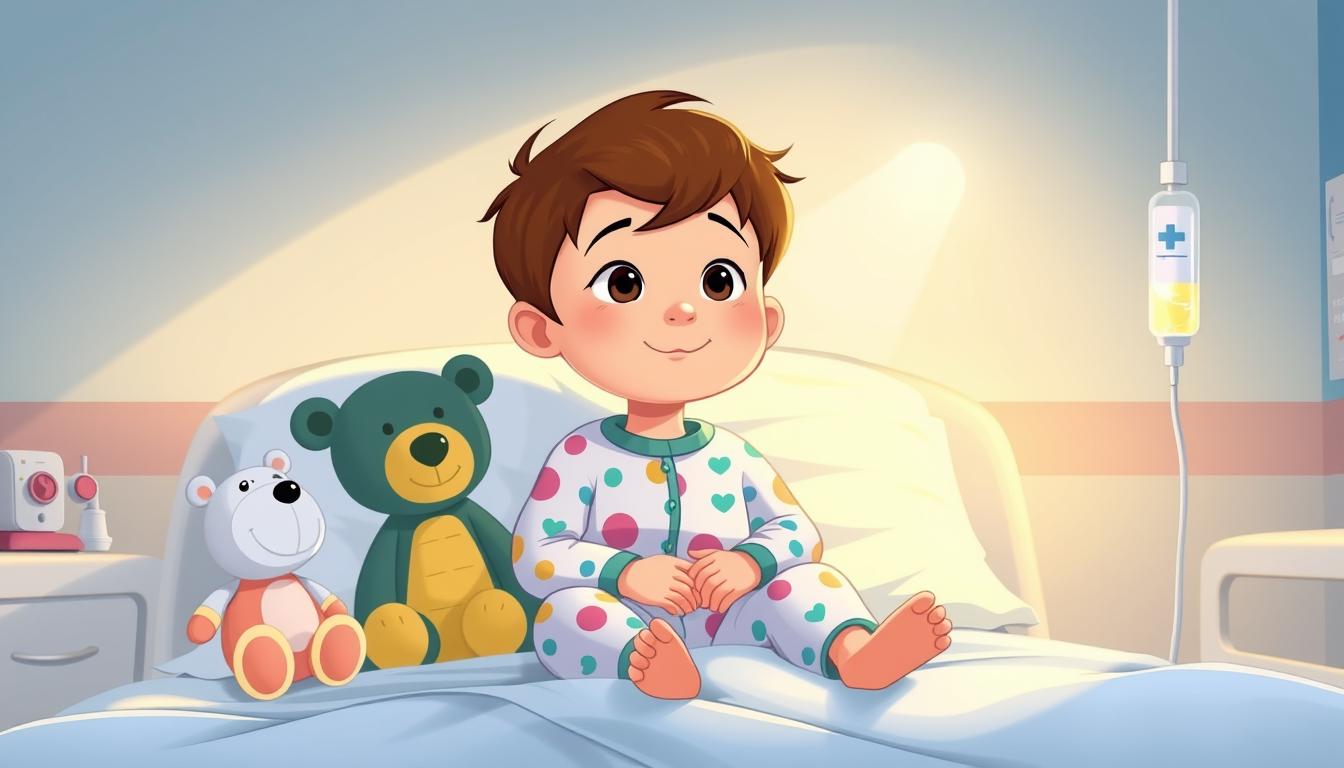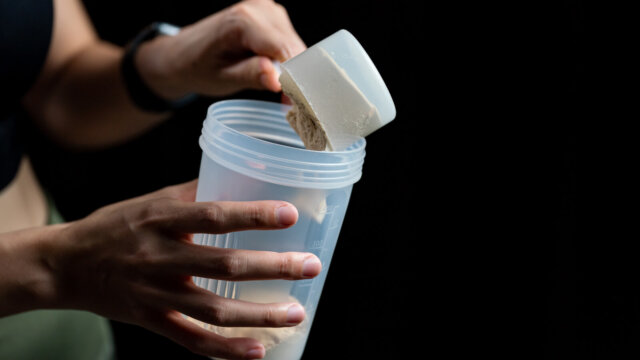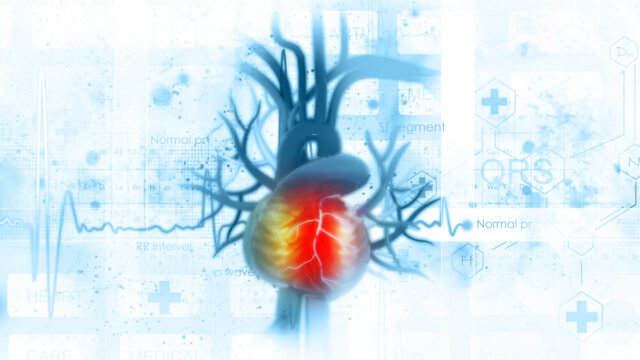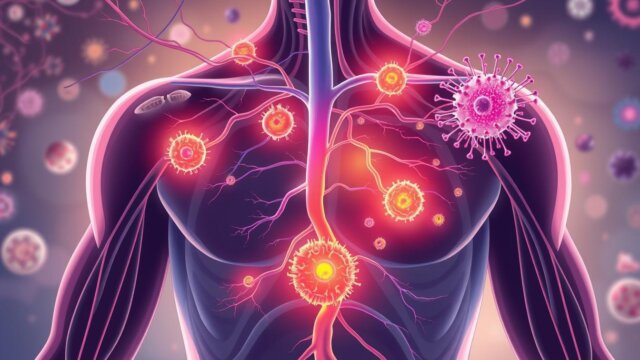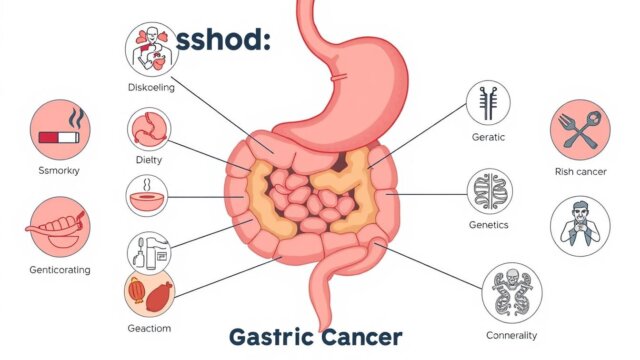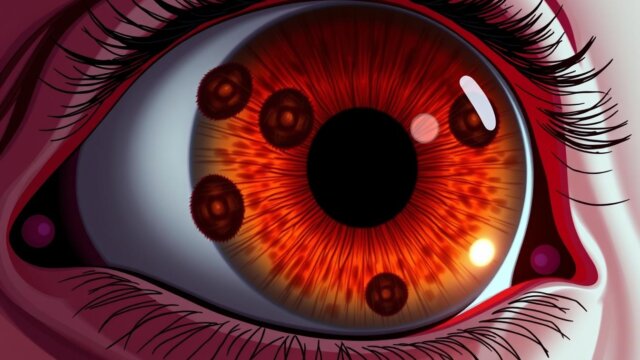FTC disclaimer: This post may contains affiliate links and we will be compensated if you click on a link and make a purchase.
Leukemia is the most common cancer in kids, hitting about 4,000 children each year in the U.S. One in three kids with cancer has leukemia. This blood cancer starts in the bone marrow and brings tough symptoms that need quick doctor visits and special care. Knowing the signs and treatments is key for the best results for kids and their families.
Key Takeaways
- Leukemia is the most common type of cancer in children, affecting around 4,000 kids per year in the U.S.
- The two main types of childhood leukemia are Acute Lymphoblastic Leukemia (ALL) and Acute Myelogenous Leukemia (AML).
- Symptoms of childhood leukemia can include anemia, bleeding, infections, bone/joint pain, abdominal issues, and neurological problems.
- Early diagnosis and prompt, comprehensive treatment are essential for managing childhood leukemia and improving long-term prognosis.
- Specialized care from pediatric oncologists and hematologists is crucial for providing the best possible outcomes for children with leukemia.
What is Childhood Leukemia?
Childhood leukemia is a blood cancer that affects white blood cells. Leukemia cells grow fast, taking over the bone marrow, where healthy cells live.
There are different types of childhood leukemia. Each type has its own traits and treatment plans.
Types of Childhood Leukemia
The main types are Acute Lymphoblastic Leukemia (ALL), Acute Myelogenous Leukemia (AML), and Chronic Myelogenous Leukemia (CML). ALL is the most common, found in 75-80% of cases. AML is seen in young kids and teens. CML is rare in children.
Acute Lymphoblastic Leukemia (ALL)
ALL is the most common type, making up 75% of cases. It’s caused by fast-growing immature lymphocytes in the bone marrow.
Acute Myelogenous Leukemia (AML)
AML is the second most common, affecting 20% of cases. It starts in myeloid cells, which turn into different blood cells.
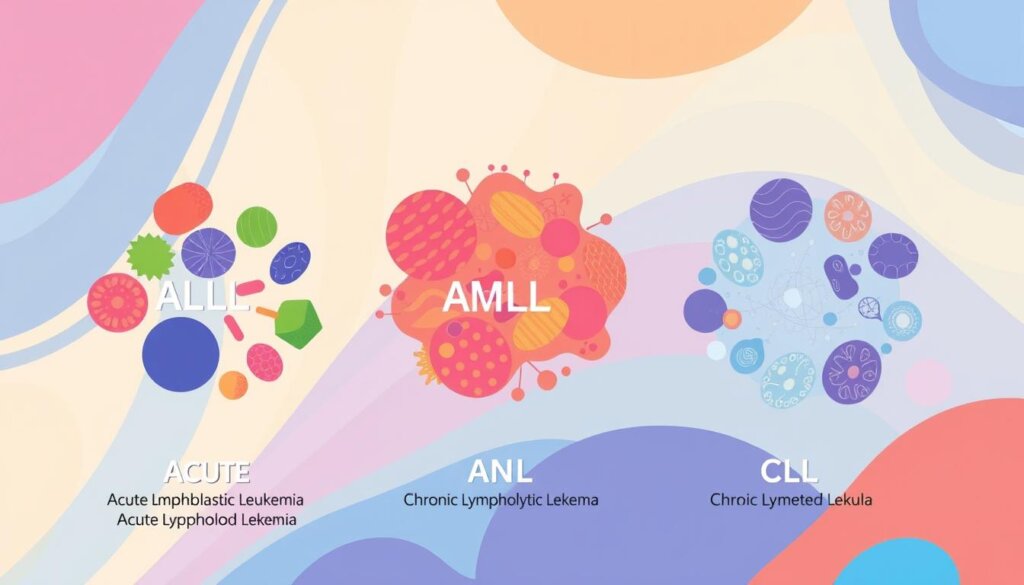
Type of Leukemia | Percentage of Childhood Leukemia Cases |
|---|---|
Acute Lymphoblastic Leukemia (ALL) | 75-80% |
Acute Myelogenous Leukemia (AML) | 20% |
Chronic Myelogenous Leukemia (CML) | Rare in children |
Chronic Lymphocytic Leukemia (CLL) | Extremely rare in children |
Childhood Leukemia Symptoms
Leukemia is the most common cancer in kids. It causes symptoms from too many bad blood cells. This makes it hard for healthy cells to work right.
Symptoms of Anemia
Anemia is a big sign of leukemia in kids. It happens when there aren’t enough red blood cells. Kids might feel very tired, look pale, and have trouble breathing.
Symptoms of Low White Blood Cells
Leukemia can also lower white blood cells, which help fight infections. So, kids with leukemia might get sick more often.
Symptoms of Low Platelets
Leukemia can also lower platelets. Platelets help blood clot. Kids might bruise easily, get nosebleeds, and bleed a lot from small cuts.
Symptoms can come on fast with acute leukemia or slowly with chronic leukemia. Watching your child’s health closely is key. If you see any lasting or worrying signs, get medical help right away.
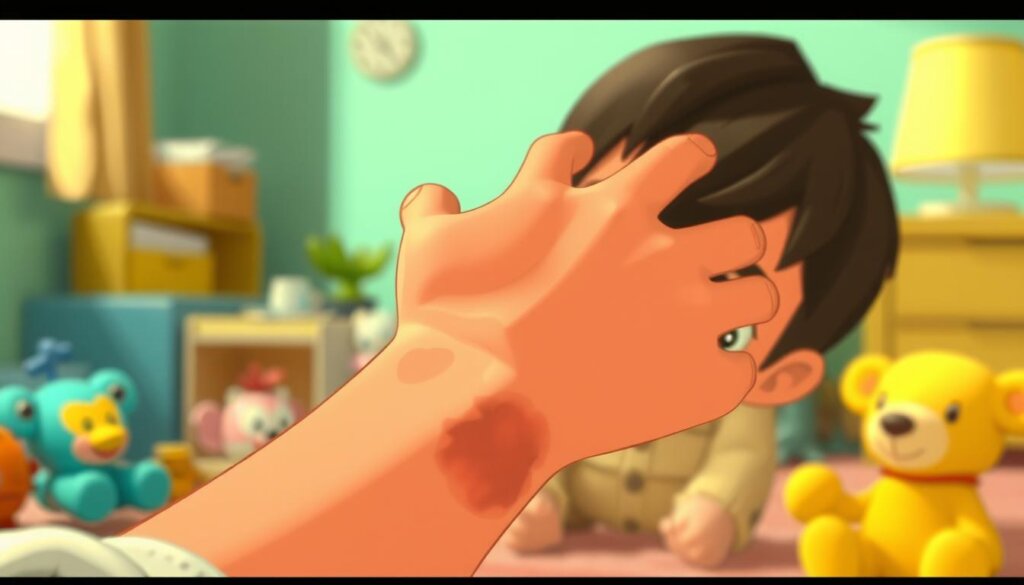
“Leukemia is the most common cancer in children, accounting for nearly 1 out of 3 childhood cancers.” – American Cancer Society
Causes of Childhood Leukemia
The exact causes of childhood leukemia are still a mystery. Researchers have found several risk factors that might help explain it. Changes in the immune system and certain genetic conditions can raise the risk of this disease.
Some inherited genetic mutations, like those in Li-Fraumeni syndrome, increase the risk of childhood leukemia. But most cases are not caused by inherited genes. Most DNA changes happen after a child is born, not from parents.
Exposure to radiation or harmful chemicals can also lead to a few cases of childhood leukemia. Some studies suggest that both genetic and environmental factors might cause certain types of childhood leukemia.
Other possible risk factors include parental exposure to pesticides, benzene, and high birth weight. However, more research is needed to fully understand these connections.

Right now, we don’t know the exact causes of most childhood leukemias. Different types might have different causes. Scientists are still studying how genetics, environment, and the immune system might all play a part.
Diagnosis of Childhood Leukemia
Diagnosing childhood leukemia involves a detailed check-up. This includes a medical history, physical exam, and various tests. These tests help determine the type of leukemia and abnormal cells and plan treatment.
Bone Marrow Tests
A bone marrow test is key for diagnosing leukemia. It takes a small bone marrow sample, usually from the hip. This test looks at blood cells and finds abnormal ones. It helps figure out the leukemia type and stage, guiding treatment.
Blood Tests
Blood tests, like a complete blood count (CBC), show low blood cell levels that might mean leukemia. Blood smear tests also check for abnormal blood cells, helping diagnose leukemia.
Imaging Tests
Imaging tests, like CT scans and X-rays, check for signs of leukemia in the body. They look for organ changes or growths, such as in the liver or spleen, which can occur in leukemia.
Together, these tests help doctors accurately diagnose leukemia. They then create a treatment plan that fits the child’s needs.
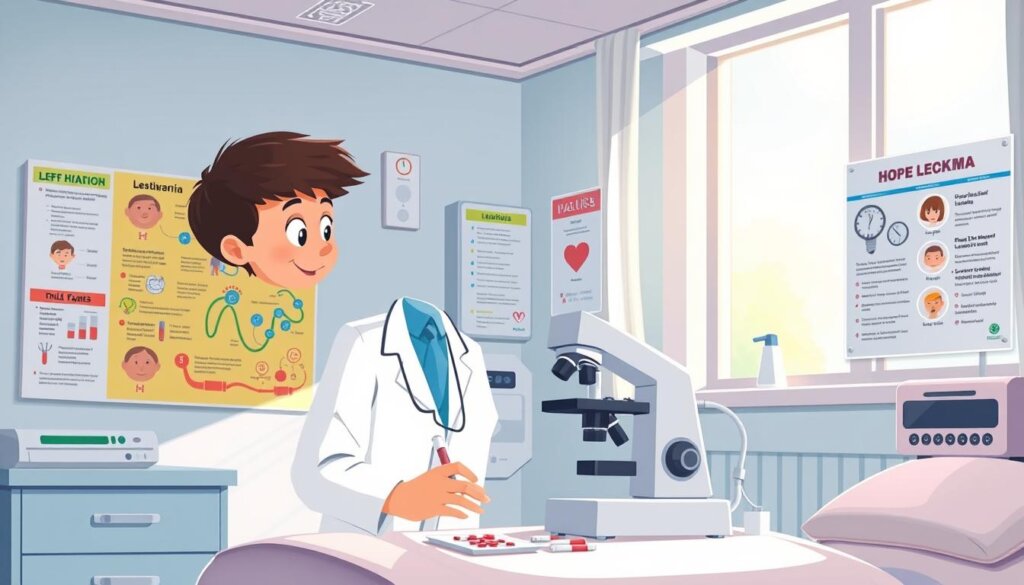
“Accurate and timely diagnosis is crucial for the effective treatment of childhood leukemia, as it allows healthcare providers to develop personalized care plans that address the unique needs of each patient.”
Treatment for Childhood Leukemia
Treating childhood leukemia starts with addressing symptoms like anemia and bleeding. The main treatments are chemotherapy, radiation therapy, and stem cell transplantation.
Chemotherapy
Chemotherapy is the main treatment for childhood leukemia. It uses drugs to kill leukemia cells. Each child’s treatment plan is based on age and disease type.
Radiation Therapy
Radiation therapy targets leukemia cells in specific areas, making it useful for treating leukemia in the central nervous system or other organs.
Stem Cell Transplantation
For high-risk cases, a stem cell transplant is recommended. It replaces unhealthy bone marrow with healthy stem cells. This can be a good option for some children with leukemia.
The treatment plan for a child with leukemia is made just for them. It considers their leukemia type, age, and how they respond to treatment. Getting a second opinion is often advised for the best care.
Caring for a Child with Leukemia
Caring for a child with leukemia is a big challenge. It needs a lot of support from the family. Leukemia is the most common cancer in kids. Treatment can last years and includes many steps like medicines and radiation.
Families must help with the child’s physical, emotional, and daily needs, which is very important during treatment.
It is key to monitor the child’s symptoms and manage treatment side effects. Kids might feel sick, tired, and uncomfortable. They need careful care and changes in their daily lives.
Good food, water, and rest can help them feel better. Families should talk to doctors to make the best choices for their child.
Emotional support is also very important. Creating a loving space, playing, and meeting other families can help the child feel better. Talking to doctors, getting help, and counseling can also be very helpful.
It’s a tough job, but families can do it with the right help. Most kids with leukemia get better. But, the journey is hard. Family love and support can make a big difference.
“The love and support of my family kept me going through the darkest days of my treatment. They were my rock, my strength, and my reason to keep fighting.”
– Emily, a childhood leukemia survivor
Childhood Leukemia Survival Rates
Childhood leukemia survival rates have gotten much better over the years. Now, about 85% of kids with leukemia can survive for five years without the disease coming back. But, some kids might see the disease come back after they first get better.
Things like the type of leukemia, how old the child is, and how well they respond to treatment matter a lot. Acute lymphocytic leukemia (ALL) is the most common type in kids. It now has a 5-year survival rate of about 90%, which is a big jump. Kids who are at lower risk tend to do better than those at higher risk.
Acute myelogenous leukemia (AML) has seen its survival rates go up to 65% to 70% over time. A subtype of AML, acute promyelocytic leukemia (APL), has cure rates over 80%. Juvenile myelomonocytic leukemia (JMML) has a 5-year survival rate of about 50%. Chronic myeloid leukemia (CML) in kids used to have survival rates between 60% to 80%. But, new medicines are making these rates even higher now.
Research and new treatments are making a big difference for kids with leukemia. At Johns Hopkins All Children’s Cancer & Blood Disorders Institute, the 5-year survival rates for many types of leukemia are 93 percent or higher. This program is also ranked as a Top 50 Children’s Cancer Program by U.S. News & World Report for 2023-2024.
Even though fighting leukemia is tough, the progress in treatment and care is making a huge difference for these kids.
Childhood Leukemia Research
Researchers are always trying to learn more about childhood leukemia and find better treatments. They use tests like PCR to find very small leukemia cells. New tests, like NGS, might help see if treatments work. Also, kids who go to daycare early might have a lower risk of leukemia.
New treatments for childhood leukemia are being developed. CAR T-cell therapy is showing great promise in some cases of ALL. Blincyto is also being used to treat B-cell ALL.
Researchers are studying new drugs, such as FLT3 inhibitors and IDH inhibitors. They also want to use BCL-2 inhibitors to fight leukemia.
Clinical trials are key in finding new treatments for childhood leukemia. Leukemia affects about 3,800 kids in the U.S. each year. Most cases are Acute Lymphoblastic Leukemia (ALL).
Research is bringing hope to kids and their families. The Children’s Leukemia Research Association supports this important work.
“Research is the foundation for progress in the fight against childhood leukemia. Every discovery, every new treatment, every improved outcome starts with the tireless work of researchers committed to finding a cure.”
Resources for Childhood Leukemia
If your child has been diagnosed with childhood leukemia, there are many resources to help you. Organizations like the Leukemia & Lymphoma Society and St. Jude Children’s Research Hospital offer lots of information and support. They also help with the costs of traveling for treatment.
Local hospitals and cancer centers are also key, with teams ready to help. They guide families through treatment, help kids go back to school, and support caregivers who have a lot to do.
Online communities and forums are great for connecting with others. You can also seek help from professional resource navigators and oncology social workers.
It’s important to ask for help from friends and family too. Taking care of yourself helps you care for your child better. With all these resources, your child will get the best care, and your family will get the support it needs.
Organization | Services Offered |
|---|---|
Leukemia & Lymphoma Society | Information, patient support, research funding |
St. Jude Children’s Research Hospital | Specialized care, clinical trials, financial assistance |
American Childhood Cancer Organization | Patient education, advocacy, support services |
Cancer Care Co-Pay Assistance Foundation | Financial assistance for cancer treatment co-pays |
Cancer Commons | Personalized treatment guidance and resources |
Cancer Support Community | Support through a network of local affiliates |
By using these childhood leukemia resources, support organizations, and patient education materials, families can face the challenges of childhood leukemia together.
Conclusion
Childhood leukemia is a tough disease, but research and treatments are getting better. In high-income countries, cancer is the top killer of kids. Every year, about 1,850 kids under 15 in Germany get cancer.
Leukemia, especially ALL, makes up 27-35% of childhood cancers. Most ALL cases are B-lineage.
Early detection and care are key to fighting this disease. Families can help by knowing the symptoms and where to find help. Leukemia can come back, especially in the first year after treatment.
Doctors check kids often in the first year and less after.
Even though it’s tough, there’s hope for kids with leukemia. Survivors might face new cancers or health issues later. The Children’s Oncology Group helps keep an eye on survivors for long-term health.
FAQ
What is the most common type of childhood leukemia?
Acute Lymphoblastic Leukemia (ALL) is the most common type of childhood leukemia. It affects 75-80% of cases.
What are the main symptoms of childhood leukemia?
Symptoms include anemia, which causes fatigue and pale skin. It also leads to shortness of breath.
Increased infections, such as fever and cough, are common. Easy bruising and bleeding are also signs. Other symptoms include bone and joint pain, abdominal pain, and breathing trouble.
What are the main risk factors for childhood leukemia?
Some risk factors include genetic conditions like Down syndrome. Li-Fraumeni syndrome is another. Previous chemotherapy or radiation for other cancers also increases the risk.
How is childhood leukemia diagnosed?
Diagnosis involves a medical history and physical exam. Blood tests and bone marrow tests are also used.
A bone marrow aspiration and/or biopsy are done. These tests examine the blood cells.
What are the main treatment approaches for childhood leukemia?
Treatments include chemotherapy, radiation therapy, and stem cell transplantation. The plan is based on the child’s age and disease type.
What is the survival rate for childhood leukemia?
Survival rates have improved a lot. 85% of patients are event-free survivors. But, some may experience relapse.
What resources are available for families of children with leukemia?
Many organizations help, like the Leukemia & Lymphoma Society. St. Jude Children’s Research Hospital and the American Childhood Cancer Organization also offer support. They provide information, patient services, and fund research.
